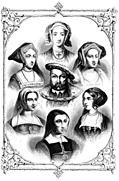Catherine Parr
, sixth and last queen to Henry VIII. celebrated for her learning, whose perfections, though a widow, attracted the heart of this monarch, and whose prudence preserved her from the effects of his cruelty and caprice, was the daughter of sir Thomas Parr, and was married first to Edward Burghe, and secondly to John Neville, lord Latimer, whose widow she was when king Henry cast his affections on her. She was early educated in polite literature, as was the fashion of noble women at that time in England, and in her riper years was much given to reading and studying the Holy Scriptures. Several learned men were retained as her chaplains, who preached to her every day in her privy chamber, and often touched such abuses as were common in the church. The king approved of this practice, and often permitted her to confer with him on religious subjects. But when disease and confinement added to his natural impatience of contradiction, and when in the presence of the bishop of Winchester and others of the popish faction, she had been urging her old topic of perfecting the reformation, the king broke out into this expression after she was retired, | “A good hearing it is, when women become such clerks and a thing much to mycomfort, to come in mine old age to be taught by my wife” Winchester failed not to improve this opportunity to aggravate the queen’s insolence, to insinuate the danger of cherishing such a serpent in his bosom, and to accuse her of treason cloaked with heresy; and the king was prevailed upon to give a warrant to draw lip articles to touch her life. The day and hour was appointed, when she was to be seized: but the design being accidentally discovered to her, she waited upon the king, who received her kindly, and purposely began a discourse about religion. She answered, <* That women by -their creation at first were made subject to men; that they, being made after the image of God, as the women were after their image, ought to instruct their wives, who were to learn of them: and she much more was to be taught of his majesty, who was a prince of such excellent learning and wisdom.*' “Not so, by St. Mary,” said the king, “you are become a doctor, Kate, able to instruct us and not to be instructed by us.” To which she replied, “that it seemed he had much mistaken her freedom in arguing with him, since she did it to ejigage him in discourse, to amuse this painful time of his infirmity, and that she might receive profit by his learned discourse; in which last point she had not missed of her aim, always referring herself in these matters, as she ought to do, to his majesty.” “And is it even so, sweetheart?” said the king, “then we are perfect friends again.”
The day which had been appointed for carrying her to the Tower being fine, the king took a walk in the garden, and sent for the queen. As they were together, the lord chancellor, who was ignorant of the reconciliation, came with the guards. The king stepped aside to him, and after a little discourse, was heard to call him “Knave, aye, errant knave, a fool, and beast;” and bid him presently avaunt out of his sight. The queen, not knowing on Tvhat errand they came, endeavoured with gentle words to qualify the king’s anger. “Ah! poor soul,” said the king, “thou little knowest how ill he deserves this at thy hands: on my word, sweetheart, he hath been toward thee an errant knave; and so let him go.” The king, as a mark of his affection, left her a legacy of 4000l. besides her jointure. She was afterwards married to sir Thomas Seymour, lord-admiral of England, and uncle to Edward VI. but she lived a very short time, and that unhappily, | with this gentleman. She died, in 1548, in child-bed; though, as some writers observe, not without a suspicion of poison, to make way for Seymour’s marriage with the princess Elizabeth. She was buried in the chapel of Sudley-castle. Her leaden coffin having been explored by female curiosity in 1782, her features, and particularly her eyes, are said to have appeared in a state of perfect preservation.
Her majesty wrote, “Queen Catherine Parr’s Lamentation of a Sinner, bewailing the Ignorance of her blind life.” This was a contrite meditation on the years she had passed in popery, in fasts, and pilgrimages; and, being found among her papers after her death, was published with a preface, by the great lord Burleigh, in 1548, 8vo, and afterwards, in 1563. In her life-time she published a volume of psalms, prayers, and pious discourses, with this title; “Prayers or Meditations, wherein the mind is stirred patiently to suffer all afflictions here, and to set at nought the vain prosperitie of this worlde, and always to long for the everlasting felicitee,” 1545, 12mo. Several letters of this queen’s are preserved in “Strype’s Annals,” in “Haynes’s collection of State Papers,” in the “Ashmoiean Collection,” and in the library of C. C. C. Cambridge. 1




![[the book]](../../g/51A85AaLk0L._SL160_.jpg)